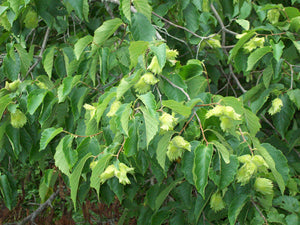Beaked Hazelnut, (Corylus cornuta)
Shipping calculated at checkout
95 in stock
Need more? Contact us
This tree needs pollination
Compatible trees:
American hazelnut, corylus americana 3a-3b
American hazelnut, corylus americana 3a-3b
This shrub, approximately 3 m high, forms bushes. Its alternate, oval leaves, heart-shaped at the base and pointed at the top, have a doubly toothed outline (with large teeth broken into finer teeth). Its flowers are of two types: the male flowers form hanging catkins, the female flowers, solitary and very small, are light red. Its dried fruit is a nut contained in a spiny envelope ending in a long beak.
Housing, distribution
It is common and abundant in most of our forests, especially in maple groves with yellow birch, yellow birch groves, forests bordering watercourses (such as ash elm groves) and transitional forests dominated by aspen. . It also lives in humid or marshy shrub groups. It is found in deciduous forest, mixed forest and boreal forest regions up to the latitude of Chibougamau.
Ecology
Hares, deer, and moose graze on it. The partridge eats its kittens, the birds nest in its branches and the squirrels search for its nuts.
Use
The famous divining rod is in fact a branch of hazel, or hazel, in the shape of a “Y”.
Its nut is well known, as is its envelope covered with a multitude of small needles which cling to the skin. The best way to shell these dried fruits remains that of the Amerindians: simply place the ripe hazelnuts in a bag and tap it against a hard surface. From the nut, we can make a flour which is used in the preparation of hazelnut bread.
The bark of the hazel tree is reputed to fight fever. Native American tribes had several medicinal uses. The Fatheads used the ends of its branches to make a herbal tea against heart disease. The Abenakis infused its bark with that of the red hart and willow to treat eye ailments. The Iroquois threaded fragments of its stem into necklaces to relieve teething pain in young children.




